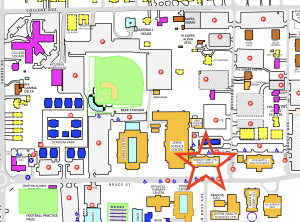Dr. Edmond E. Griffin Planetarium
The Dr. Edmond E. Griffin Planetarium, located on the University of Central Arkansas Campus in the Conway Corporation Center for the Sciences, serves as an astronomy and science education resource center for central Arkansas. The planetarium is part of the outreach component of the Department of Physics, Astronomy, and Engineering, and as such, it supports astronomy teaching on campus, as well as, offers planetarium shows to school groups and the general public.
Summer 2025 Public Shows
The one-hour shows are Fridays starting at 3:00pm and 7:00pm. Entry to the planetarium begins ten minutes before the shows. NO admittance once the shows start. Seating for Public Shows is on a first-come basis with maximum possible capacity of 94. Please be aware that no food or drink is allowed in the Conway Corporation Center for the Sciences building. Admission is currently free. Donations to the Griffin Planetarium through the Secure Giving link are encouraged.
May 30, 3pm and 7pm: River of Bears
“River of Bears is about the legendary McNeil River Alaska State Game Sanctuary. During the summertime it hosts the largest congregation of brown bears in the world. Bears come from hundreds of miles to the sanctuary to mate, raise cubs, and dine on the abundant sedge grass and salmon. On a typical day in July over fifty bears can be seen at the McNeil River falls, feasting on salmon desperately swimming upstream to spawn. The show tells the remarkable story of these bears as they prepare for the coming harsh Alaska winter, and the visitors and scientists who come every summer to see them.”

June 6, 3pm and 7pm: Experience the Aurora
“Over seven months in the Arctic Circle, our crews captured time-lapse images of the Aurora Borealis with high resolution digital SLR cameras outfitted with fisheye lenses. The results are spectacular. For the first time the aurora has been captured as it was meant to be experienced, as a display that covers the entire sky. This immersive show shares the science behind the aurora and tells the story of our quest to find and photograph the aurora for wraparound display in fulldome theaters. Winner of 2 Telly Awards.”

June 13, 3pm and 7pm: One Sky
“In an effort to foster greater understanding of humanity’s connection to the sky, the One Sky Project, which is led by the ‘Imiloa Astronomy Center, sponsored by the Thirty Meter Telescope, and supported by the California Academy of Sciences, the Franklin Institute, NSF’s NOIRLab, and the Thirty Meter Telescope, has released a compiled feature film focusing on cultural and Indigenous astronomy. The project is an international collaboration that seeks to build cross-cultural connections and increase understanding of different Indigenous perspectives while demonstrating how our one sky connects us all.”

June 20, 3pm and 7pm: Supermassive Black Holes, Uncovering the Invisible
“Leading scientists in observational and theoretical studies of black holes and galaxies, industrial experts in cutting-edge big technologies, and professionals in science dissemination have been brought together to set up research projects which will combine the latest state-of-the-art observations, numerical simulations and innovative analytic tools to compare theory with observation, and shed light on the physics of black hole formation in the context of galaxy evolution. This planetarium show presents the environments of the black holes in an impressive and understandable way to the audience.”

June 27, 3pm and 7pm: Phantom of the Universe
“From the journey of protons racing through the world’s largest particle collider in Europe to up-close views of the Big Bang and emergent cosmos, Phantom of the Universe is designed to immerse audiences in the search for dark matter. A collaboration of Lawrence Berkeley National Lab, University of Texas at Arlington, Michigan State University, IFIC at University of Valencia, as well as other institutions. It is narrated by Oscar-winning actress, Tilda Swinton.”

August 8, 3pm and 7pm: Secret Lives of Stars
“Not all stars are created Equal. Some are massive. Others are tiny; almost insignificant. The specific characteristics of a star will determine what type of life it will lead, how long it might live and even the type of death it will die. We will witness the amazing variety of stars and peer into their secret lives. Narrated by Sir Patrick Stewart of TV’s Star Trek the Next Generation and the X-men films. Winner of 4 Telly Awards.”

August 15, 3pm and 7pm: Out There, The Quest for Extrasolar Worlds
“For thousands of years, mankind thought that the Earth was the center of the Universe. Thanks to our curiosity, imagination and urge to explore, we now know that planets like our Earth are nothing special in the cosmos. The Sun is just one ordinary star among hundreds of billions in our galaxy, the Milky Way. With the world’s most powerful telescopes, we are able to explore more and more of the Universe. What we have found so far has surpassed even the wildest expectations of scientists as well as authors of science fiction. Most stars have planets — it turns out they are more common than we thought.
A huge diversity of different worlds is out there, just waiting to be discovered.“

SUPPORT GRIFFIN:
ABOUT:
Contact:
Department of Physics and Astronomy
University of Central Arkansas phone: 501.450.5900
Conway, AR 72035 fax: 501.852.2286
Staff:
Dr. Scott Austin saustin@uca.edu
Director of Astronomical Facilities
Associate Professor of Astronomy and Physics
Department of Physics and Astronomy
University of Central Arkansas phone: 501.450.5907
Conway, AR 72035 fax: 501.852.2286
History:
From 1987 to 2015, the original UCA planetarium that was located in Lewis Science Center used an electromechanical planetarium projector and a thirty-foot dome to simulate the sky as seen from the surface of the Earth.
The current digital planetarium in the Conway Corporation Center for the Sciences consists of 94 seats under a forty-foot diameter dome onto which an Evans & Sutherland dual projector Digistar 7 system creates a virtual universe. The universe can now be seen from other locations in the universe, such as, in orbit around Saturn, near a binary star system in our galaxy, or from a galaxy a several million light years from the Earth.
The building of a new planetarium was supported by Dr. Sue Griffin, a world-class neuroscientist at the University of Arkansas for Medical Sciences, and named in memory of her husband Dr. Ed Griffin, a long-time faculty member, chair of the UCA Biology Department, and astronomy enthusiast.




